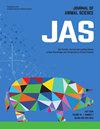96 Correlating vaginal bacteria abundance and interferon-stimulated genes in lactating dairy cattle
IF 2.7
2区 农林科学
Q1 AGRICULTURE, DAIRY & ANIMAL SCIENCE
引用次数: 0
Abstract
Pregnancy relies on a variety of physiological factors and processes for successful establishment. The reproductive microbiome appears to influence pregnancy status, and previous research suggests that the expression of interferon-stimulated genes (ISGs) may play a role on pregnancy determination in cattle. However, the relationship between ISGs and reproductive microbiome has yet to be comprehensively evaluated in dairy cattle. Thus, the objective of this study was to analyze correlations between vaginal bacteria abundance and circulating ISGs in lactating dairy cattle in open and pregnant females. Lactating Holstein cows (n=27) were sampled on day of artificial insemination (AI) and day 18 post-AI. Sterile swabs were inserted into the vagina and rotated eight times along the vaginal wall prior to storage in sterile microcentrifuge tubes at -80°C. Swab samples were utilized for subsequent bacterial abundance analyses targeting the V4 hypervariable region of the 16S rRNA gene. Blood was collected via coccygeal venipuncture, placed on ice, and centrifuged at 2500 x g and 4°C for 20 minutes. Resulting buffy coats were collected, and samples stored at -80°C for real-time quantitative polymerase chain reaction (RT-qPCR) analysis. Cows underwent transrectal ultrasonography on day 32 post-AI for pregnancy determination. Selected target genes were interferon-stimulated gene 15 kDa (ISG15) and myxovirus resistance gene 2 (MX2). Mean relative mRNA expression of ISG15 was negatively correlated with phylum Tenericutes on day of AI (r = -0.43; P = 0.03). Concurrently, mean relative mRNA expression of MX2 was negatively correlated with phylum Bacteroidetes (r = -0.35; P = 0.08) and positively correlated with phyla Actinobacteria and Tenericutes (r = 0.41 and r = 0.41, respectively; P = 0.04). On day 18, MX2 mean relative mRNA expression was positively correlated with phylum Firmicutes (r = 0.39; P = 0.05). Regarding bacterial genera abundance, mean relative mRNA expression of ISG15 was negatively correlated with Ureaplasma on day of AI (r = -0.41; P = 0.04) and positively correlated with Sneathia on day 18 (r = 0.40; P < 0.05). MX2 mean relative mRNA expression was negatively correlated with Ruminococcus (r = -0.40; P = 0.05) and positively correlated with Ureaplasma (r = 0.42; P = 0.03) on day of AI. On day 18, mean relative mRNA expression of MX2 was positively correlated with Streptococcus (r = 0.42; P = 0.04). Interestingly, genera Ureaplasma and Sneathia have been previously associated with reproductive diseases in cattle, yet the current work suggests their bacterial load may not be indicative of inflammation. Further, the positive correlation of MX2 expression with phylum Actinobacteria may indicate potential pathogenicity as it has been previously associated with infertility in both women and cattle. Additional research is needed to further determine the relationship between reproductive microbiota and ISGs during pregnancy establishment.泌乳奶牛阴道细菌丰度与干扰素刺激基因的相关性
妊娠的成功建立依赖于多种生理因素和过程。生殖微生物组似乎影响妊娠状态,先前的研究表明,干扰素刺激基因(ISGs)的表达可能在牛的妊娠决定中发挥作用。然而,ISGs与奶牛生殖微生物群之间的关系尚未得到全面的评价。因此,本研究的目的是分析开放和怀孕母奶牛阴道细菌丰度与循环ISGs之间的相关性。选取27头泌乳荷斯坦奶牛,分别于人工授精第1天和人工授精后第18天取样。将无菌拭子插入阴道,沿阴道壁旋转8次,然后在-80°C的无菌微离心管中保存。拭子样本用于随后针对16S rRNA基因V4高变区进行细菌丰度分析。经尾骨静脉穿刺采血,置于冰上,在2500 x g、4°C离心20分钟。收集得到的灰白色外套,将样品保存在-80°C,用于实时定量聚合酶链反应(RT-qPCR)分析。人工授精后第32天对奶牛进行经直肠超声检查以确定妊娠。选择的靶基因为干扰素刺激基因15kda (ISG15)和黏液病毒抗性基因2 (MX2)。AI当天ISG15 mRNA的平均相对表达量与微小门呈负相关(r = -0.43;P = 0.03)。同时,MX2的平均相对mRNA表达量与拟杆菌门呈负相关(r = -0.35;P = 0.08),与放线菌门和微内菌门呈正相关(r = 0.41和r = 0.41);P = 0.04)。第18天,MX2平均相对mRNA表达量与厚壁门呈正相关(r = 0.39;P = 0.05)。在细菌属丰度方面,AI当天ISG15的平均相对mRNA表达量与脲原体呈负相关(r = -0.41;P = 0.04),与第18天Sneathia呈正相关(r = 0.40;P, lt;0.05)。MX2平均相对mRNA表达量与瘤胃球菌呈负相关(r = -0.40;P = 0.05),且与脲原体呈正相关(r = 0.42;P = 0.03)。第18天,MX2的平均相对mRNA表达量与链球菌呈正相关(r = 0.42;P = 0.04)。有趣的是,脲原体属和Sneathia属以前与牛的生殖疾病有关,但目前的工作表明,它们的细菌负荷可能不是炎症的指示。此外,放线菌门与MX2表达的正相关可能表明潜在的致病性,因为它以前与妇女和牛的不孕症有关。需要进一步的研究来进一步确定怀孕期间生殖微生物群与isg之间的关系。
本文章由计算机程序翻译,如有差异,请以英文原文为准。
求助全文
约1分钟内获得全文
求助全文
来源期刊

Journal of animal science
农林科学-奶制品与动物科学
CiteScore
4.80
自引率
12.10%
发文量
1589
审稿时长
3 months
期刊介绍:
The Journal of Animal Science (JAS) is the premier journal for animal science and serves as the leading source of new knowledge and perspective in this area. JAS publishes more than 500 fully reviewed research articles, invited reviews, technical notes, and letters to the editor each year.
Articles published in JAS encompass a broad range of research topics in animal production and fundamental aspects of genetics, nutrition, physiology, and preparation and utilization of animal products. Articles typically report research with beef cattle, companion animals, goats, horses, pigs, and sheep; however, studies involving other farm animals, aquatic and wildlife species, and laboratory animal species that address fundamental questions related to livestock and companion animal biology will be considered for publication.
 求助内容:
求助内容: 应助结果提醒方式:
应助结果提醒方式:


